
Natural dyeing with pomegranate
Pomegranate holds a profound historical significance as a natural dye in Eastern cultures. Across regions like India, Persia, and Central Asia, the art of dyeing textiles with pomegranate has been an integral part of traditional practices for centuries. In many cultures, the pomegranate is a symbol of fertility, prosperity, and abundance. These cultural connotations often extend to textiles dyed with this plant. The use of pomegranate dye reflects the enduring craftsmanship passed down through generations, maintaining a link between the past and the present.
In contemporary times, there is a growing interest in reviving and preserving traditional dyeing techniques, emphasizing the beauty of the craft of natural dyeing. This practice serves as a unique bridge between contemporary textiles and the rich history and deep cultural meaning associated with a particular plant. It is a beautiful way to create a connection that spans centuries, allowing the modern world to appreciate the intricate relationship between the craft and the plant's historical and cultural significance.
The spectrum of colors yielded by pomegranate dye is diverse, ranging from warm yellows and oranges to earthy browns and deep greys, all of which are celebrated for their lightfastness. Beyond its vibrant color palette, pomegranate is rich in tannins, making it a versatile organic mordant. When combined with other botanical dyes, it expands the color possibilities and enhances the longevity and resilience of the dyed textiles, contributing to the artistry of natural dyeing.
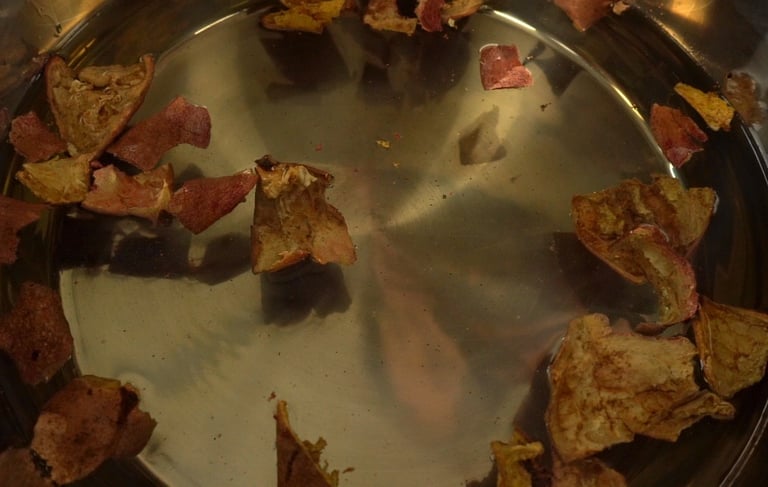

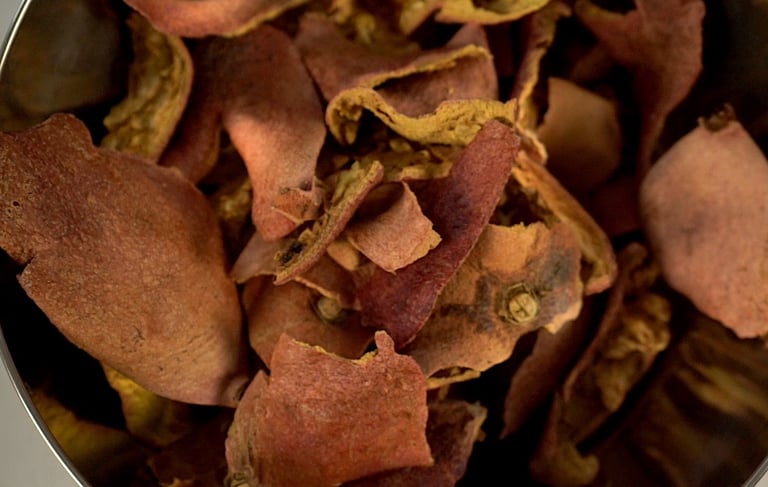

GENERAL INFORMATION
Name: pomegranate
Latin name: Punica granatum
Type: mordant dye, no-mordant dye, organic mordant
Part of the plant used: rinds
Colorants: various tannins
Main colors: yellow, grey, brown
Other colors: various shades of beige, orange, black, muted green
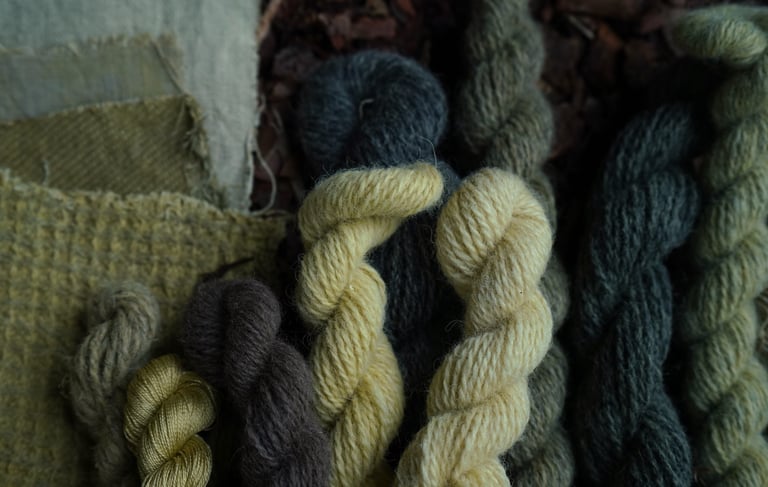

NATURAL DYEING WITH POMEGRANATE RINDS
Ingredients:
Mordanted or unmordanted textile fibers
15-30% WOF dried pomegranate rinds (15-30 grams of pomegranate rinds for each 100 g of fiber)
4-6 liters of water for each 100 g of fiber
Dyeing process:
Add pomegranate rinds to the dyeing pot filled with water, stir well.
Raise temperature to 70-85°C and simmer for 1 hour. Let it cool. You may simmer longer for darker colors.
Strain through a fine cloth to keep small particles out of the dye bath.
Add wet mordanted or not mordanted fibers, stir gently. Fibers should be soaked in water for at least 30 minutes before adding to the dye solution.
Raise temperature to 70-80°C and simmer for 30-60 minutes. Let it cool. You may simmer and soak longer for darker colors.
After dyeing, take out the fibers, gently squeeze and hang them to dry. You may leave the fibers for several days to let the colorants settle in. This process is called “air curing”.
Wash dyed fibers in room temperature water. Keep changing water until it is clean and clear.
NATURAL DYEING WITH POMEGRANATE EXTRACT
Ingredients:
Mordanted or unmordanted textile fibers
5-10% WOF pomegranate extract
4-6 liters of water for each 100 g of fiber
Dyeing process:
Dissolve the extract powder in a small amount of warm water. Stir very well to ensure that all extract is dissolved and add to your dye pot. Stir well and make sure there are no small lumps of extract and that it is all dissolved.
Fibers should be soaked in water for at least 30 minutes before adding to the dye solution. Use mordanted or unmordanted fibers.
Add wet fibers to the dye and simmer for 40-60 minutes depending on the shade you want. Leave to cool.
After dyeing, take out the fibers, gently squeeze hang them to dry. You may leave the fibers for several days to let the colorants settle in. This process
is called “air curing”.
Wash dyed fibers in room temperature water. Keep changing water until it is clean and clear.
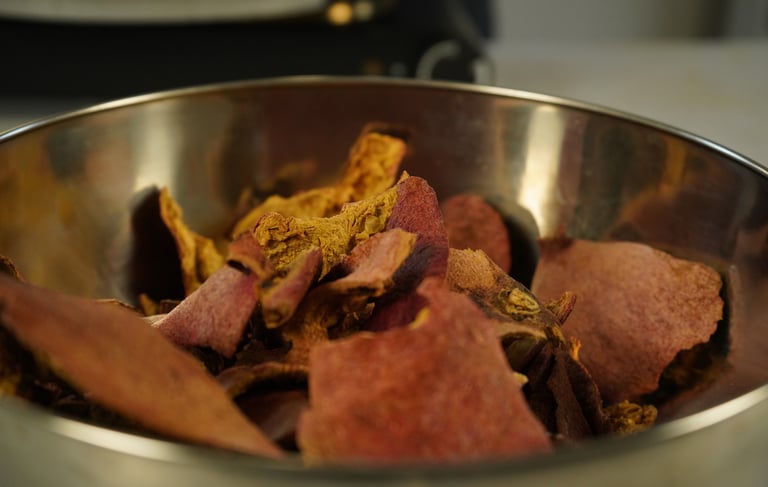

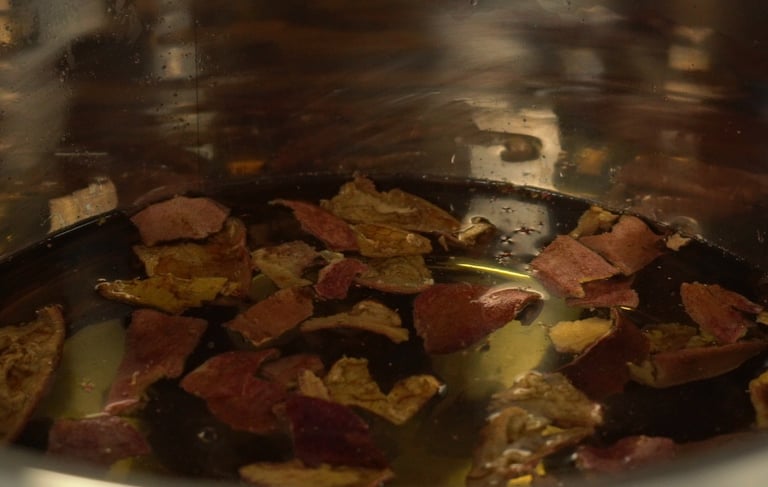

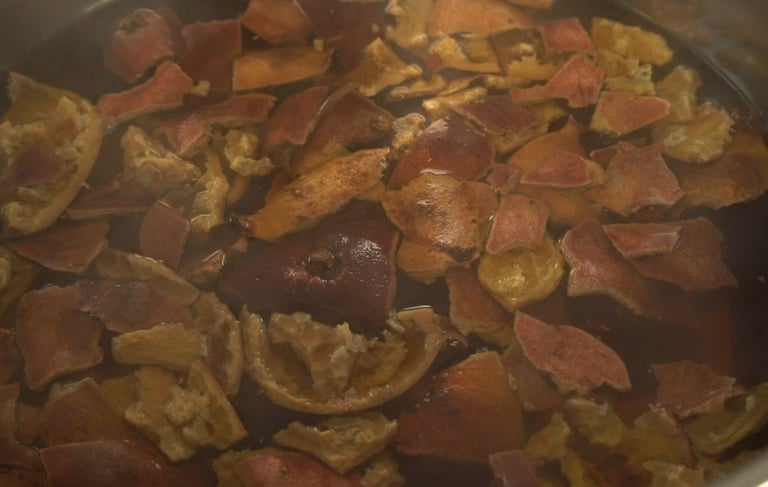

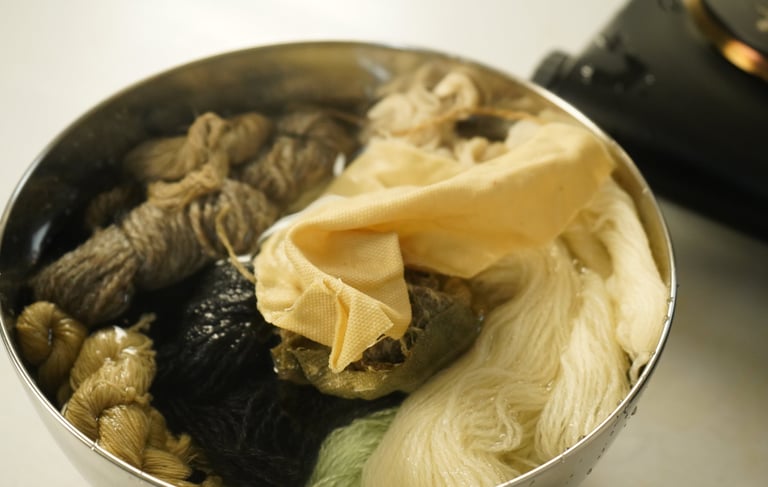

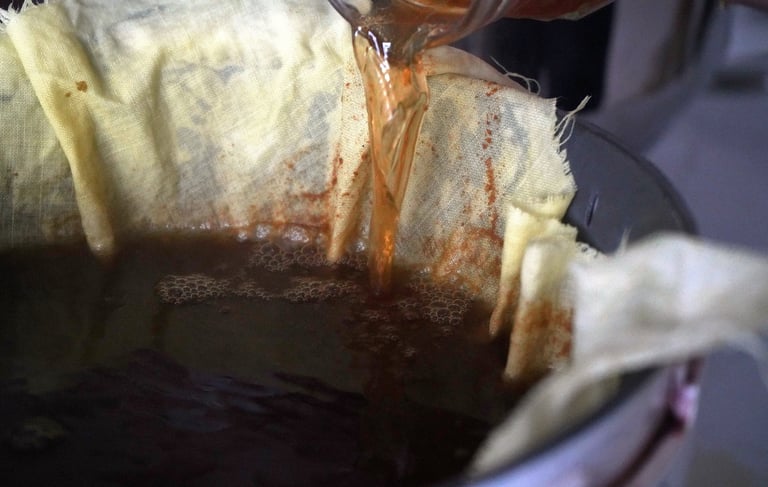


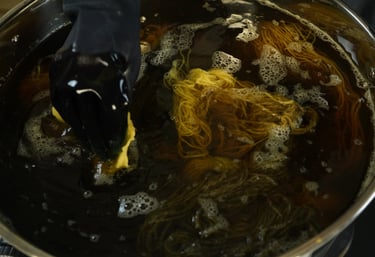
Illustrations of dyeing with pomegranate rinds: adding to the water, simmering, straining through a cloth, dyeing fibers, drying, and washing them.
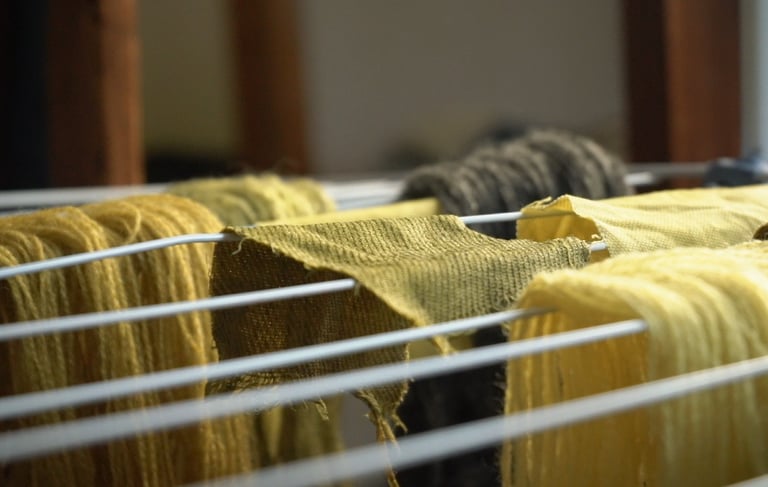

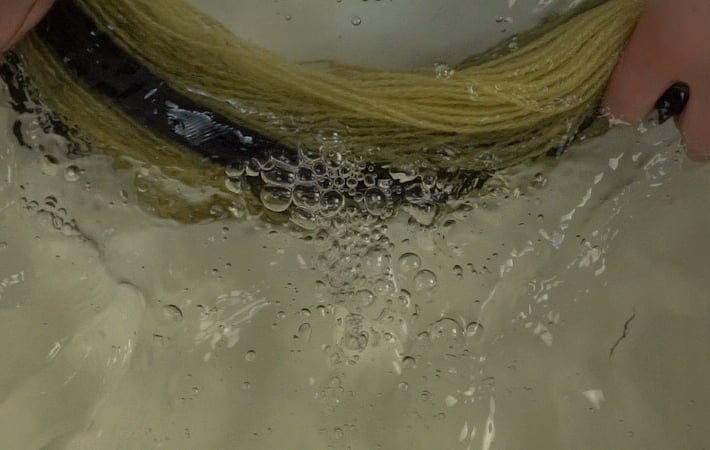

ADDITIONAL NOTES AND TIPS
Broader color palette:
To expand your color palette, experiment with post-mordanting using iron sulfate. Make a 2% iron solution, immerse wet fibers, and keep for 2-20 minutes. Observe color changes. Iron can shift pomegranate-dyed colors into deep moss greens, dark greys, and even black. The final shade depends on the first shade that went into the post-mordanting bath. After modification, wash fibers in water.
If you know you wish to get only deep, dark shades, you may add a pinch of iron sulfate directly into the pomegranate solution. This will shift colors to brown, grey, moss green, or even black.
If you have the right environment, such as a well-ventilated area or workspace outside, you may use copper sulfate the same way as iron sulfate to expand your color palette even more.
For a broader color palette, experiment with additional pH modifiers such as citric acid, cream of tartar, soda ash, or chalk. You can use them in a similar way as iron sulfate (mentioned above) - add directly into the dye or use after dyeing. Usually, this doesn’t have dramatic color changes with pomegranate, but sometimes a soft color shift is all we need.
Reusing pomegranate dye:
After dyeing your initial batch of fibers, you can use a pomegranate solution to dye the second or even third batch, with each subsequent batch resulting in lighter colors.
Reuse the pomegranate solution after dyeing as a base (instead of water) for preparing other plant dyes. For example, heating madder roots in a marigold solution yields colors ranging from soft apricots to deep reds. Simmering various other yellow-yielding plants in a pomegranate solution will enhance the lightfastness and washfastness of final colors.
You may reuse those pomegranate rinds that were strained after simmering. There won’t be an impressive amount of colorants left, but you may mix them with another dyestuff to create new shades, recipes, and work in an environment that is as sustainable as possible.
Using pomegranate rinds from your kitchen:
One of the many wonderful things about pomegranate natural dye is that it is one of the few high-quality dyes that we can find in our kitchen waste. After eating pomegranates, simply dry the rinds and store them until you have enough to prepare a dye bath.
Simmer such dried rinds a bit longer than advised in a recipe above because these dyestuff pieces are larger and may need more time to release all colorants.
Over the years, I've noticed that pomegranate rinds sold as natural dyes yield much deeper and stronger colors than the rinds collected in the kitchen. Therefore, I use around 100% WOF dried rinds from the kitchen. I'm not sure why there is such a significant color difference, but my initial thought was that, even though pomegranate rinds sold as dye stuff are labeled as waste, they may be prepared in a way that retains as many colorants as possible. Another consideration is that, living in the northern part of Europe, we may not have access to the freshest, highest-quality pomegranates, resulting in fewer colorants. Additionally, these fruits might have been grown, transported, and stored in conditions that aren't optimal for producing and retaining those colorants. Therefore, if you live in another part of the world, you may obtain deeper colors from your pomegranate rinds.
Using pomegranate as an organic mordant:
You can simply dye unmordanted fibers in the pomegranate solution following the recipes above and consider these fibers as already mordanted with tannins. Proceed to dye them with another natural dye.
Quite often, organic mordants aren’t as strong as inorganic metal salt mordants, such as alum, and they don’t provide equally lightfast and washfast results. However, some people choose to use only plant-based supplies, local materials, or have other reasons to stick to organic mordants. In this case, for the best long-lasting results, I would recommend dyeing tannin-mordanted fibers with other well-known robust plants.
RESULTS
For the purpose of this article, I've taken various fibers and different wools treated with various mordants and dyed them all together in the same solution. I prefer doing this when testing new plants or recipes because it's an excellent way to explore the diverse possibilities one recipe can produce and observe how different fibers or mordants react. I'm particularly excited to share these results with you!
One change I would consider is dividing the solution into two parts, using one for wool and another for cellulose. Through my experiences, I've noticed that wool tends to come out brighter than cellulose. Cellulose, being more challenging to dye, often requires longer simmering and soaking times to develop vibrant colors so I feel that wool fibers take up colorants faster and therefore there's less dye left for cellulose. I've primarily worked with wool, so I hadn't considered separating fibers before, but I'm planning to do this in the future to showcase even better results.
Below are the photos of my results with descriptions of fibers and mordants. Everything was dyed in the same solution of pomegranate rinds at 50% WOF, the same way as described in the instructions above. I used dried rinds collected after eating lots of pomegranate and, as written above in the 'Notes and tips" section, these rinds seem to give paler shade then pomegranate rinds sold for dyeing.
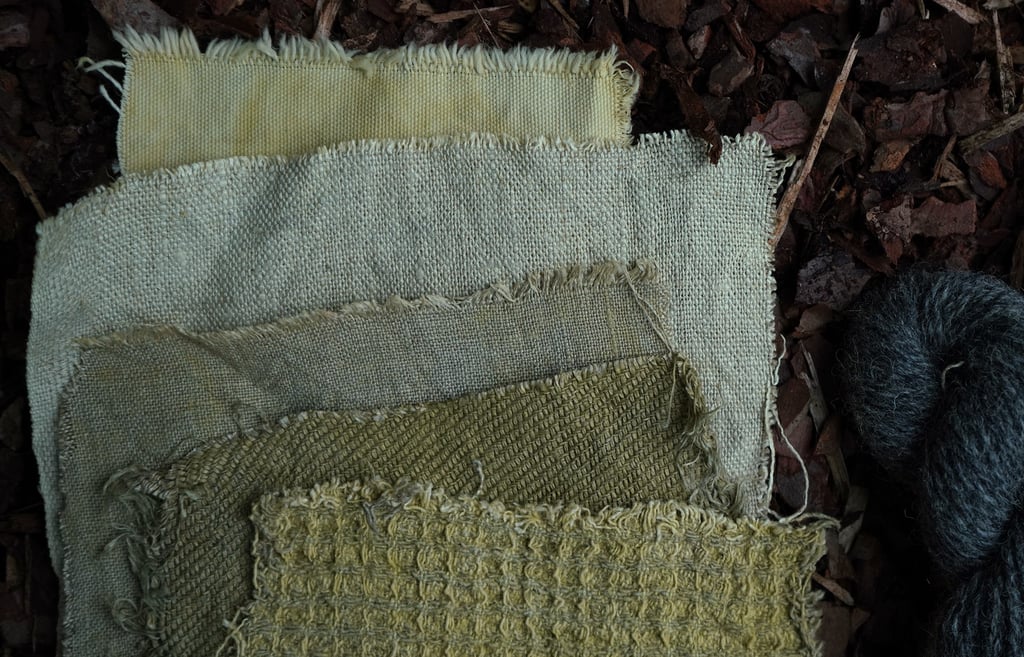

All fabrics were mordanted together with 10% myrobalan extract and 5% aluminum acetate. From top to bottom: 100% white heavy cotton, 100% white linen, 100% natural grey linen, 100% natural grey twill linen, probably 100% linen - a mix of two natural grey shades.
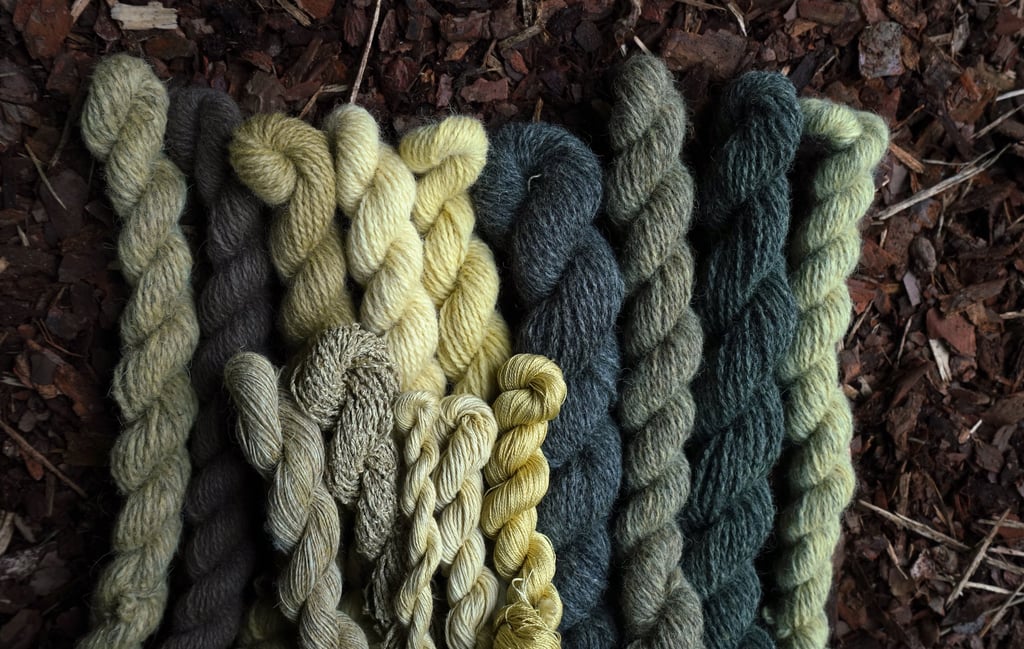

From left to right, top row: blend of wool and hemp mordanted with 12% alum; white wool mordanted with 3% iron sulfate; white wool mordanted with 4% copper sulfate; white unmordanted wool; white wool mordanted with 12% alum; dark grey unmordanted wool; natural greyish brown wool mordanted with 12% alum; natural dark grey wool mordanted with 12% alum; natural light grey wool mordanted with 12% alum.
From left to right, bottom row: 100% natural grey vintage linen, possibly handspun, 100% natural grey boucle linen, 100% white linen, 100% white cotton, all mordanted together with 10% myrobalan extract, and 5% aluminum acetate. The last skein is 100% silk mordanted with 15% alum.
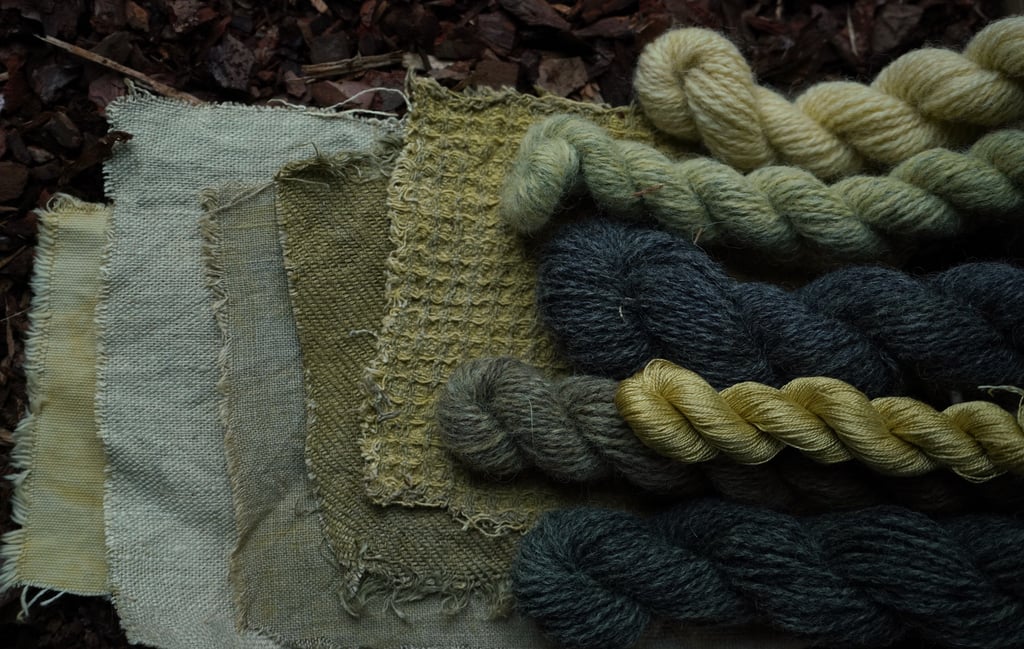

Some yarns and fabrics from the photos above for comparison.
SUPPLIES
Below is a list of ingredients which you can use for natural dyeing with pomegranate:
RELATED ARTICLES
If you are new to natural dyeing, I would recommend starting with these articles that cover the basics of scouring and mordanting:
Other recipes you may find interesting:
© Forests & Meadows 2024
Vilnius, Lithuania
LT-08200
hello@forestsandmeadows.com